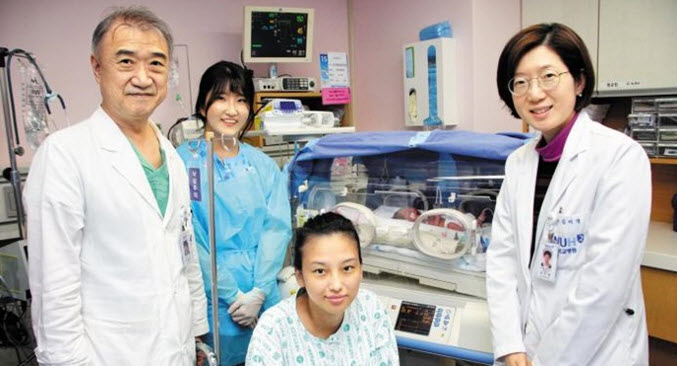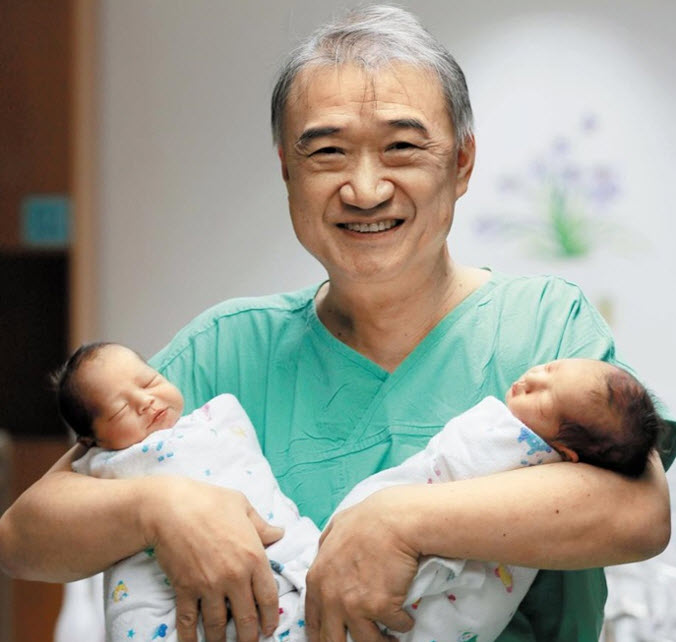
Professor JUN Jong Kwan and his patient
Professor Jun Jong Kwan of the SNU Hospital has helped deliver over 8,000 twins throughout his career and is regarded as the country’s leading expert in multiple childbirths (when a mother gives birth to more than one child at a time). This past January, he was the leading doctor in a dangerous pregnancy case which involved delivering the first child out of a set of triplets eight weeks prior to delivering the following two. This was the first such a case succeeded in South Korea.
South Korea, which is currently aging faster than any other developed country, hit a record low in terms of birthrate in 2017, with similar declines in marriage and fertility rates. There is, however, one number that seems to be on the rise: multiple births. Increasing from 9,367 multiple births in 1996 to 15,734 in 2016, this drastic jump is welcome news in an otherwise disheartening report of the country’s population trend. According to Professor Jun, an average of 300 clients visit his clinic on a yearly basis, a huge increase compared to 1990 when there were only 50-60 annual clients.

Professor Jun and a twin he helped deliver
In an interview, Professor Jun describes his thoughts and experiences working as an obstetrician:
Though the overall birth rate in Korea is at a decline, the rate of multiple births is increasing. Why do you think this is the case?
It’s simple: the development of fertility treatments has improved. It started off with a hyper-ovulation shot. Like the name implies, this shot helps females to ovulate more than they naturally would. By allowing multiple eggs to be released during ovulation, this procedure increases chance of fertilization. Because multiple eggs are in the uterus at once, the chances of having twins increase.
Who are some of your most memorable patients?
Inevitably, the bad experiences stick more with me than the good. Up until now, there were probably around 10,000 patients who visited the clinic. Around ten of them passed away. In particular, in 2004, three of my patients died in May, June, and August respectively. I thought I was going crazy. There were also patients who, showing no alarming symptoms, passed away suddenly. One Friday at 5:45pm, I was suddenly called to the emergency room. There were no abnormal symptoms. At 10pm, the patient had cardiac arrest and at 11pm, passed away. The cause of death was unknown and the patient’s husband declined the autopsy procedure.
What are some examples of false information given to the public about pregnancy?
To name one, there are too many dietary restrictions for pregnant women. Most of them have no scientific backing. I personally advise expecting mothers to refrain from smoking and drinking alcohol but other than that, I support them in eating what they want and living as they please. Even a cup of coffee a day is fine in my opinion. The same goes for prenatal education, which I am opposed to. There is no scientific proof that prenatal education has any positive effects and if you examine it closely, rather than helping expecting mothers, it represses them. Working mothers often do not have the time to enroll in such programs and are made to feel guilty about something that doesn’t even have proper evidence to support its efficacy. For a healthy pregnancy and delivery, the most important factor is the mother’s health. Our society however, makes them feel guilty, which is the opposite of what we need.
What is the meaning of life to a doctor who brings so many lives into this world?
Life is possibility. Limitless possibility. There was one particular case involving a set of twins. During week 18 of the pregnancy, the amniotic sac of the twin located on top burst open. The placenta linking the fetus to the mother detached. I thought the child had passed away, but because it was on top of the second child, we couldn’t even remove it without endangering the second child. After that, we didn’t even bother with ultrasound for the first child. At week 28, we delivered the second child. And do you know what happened? The child I had deemed dead was actually alive. Healthy too! Since then, I have made it my resolve to never give up when it comes to life. Even if the mother gives up, I will not.
Written by Yu Young Jin, SNU English Editor coin1234@snu.ac.kr
Reviewed by Professor Travis Lamar Smith, Department of Asian Languages and Civilizations, tlsmith@snu.ac.kr

